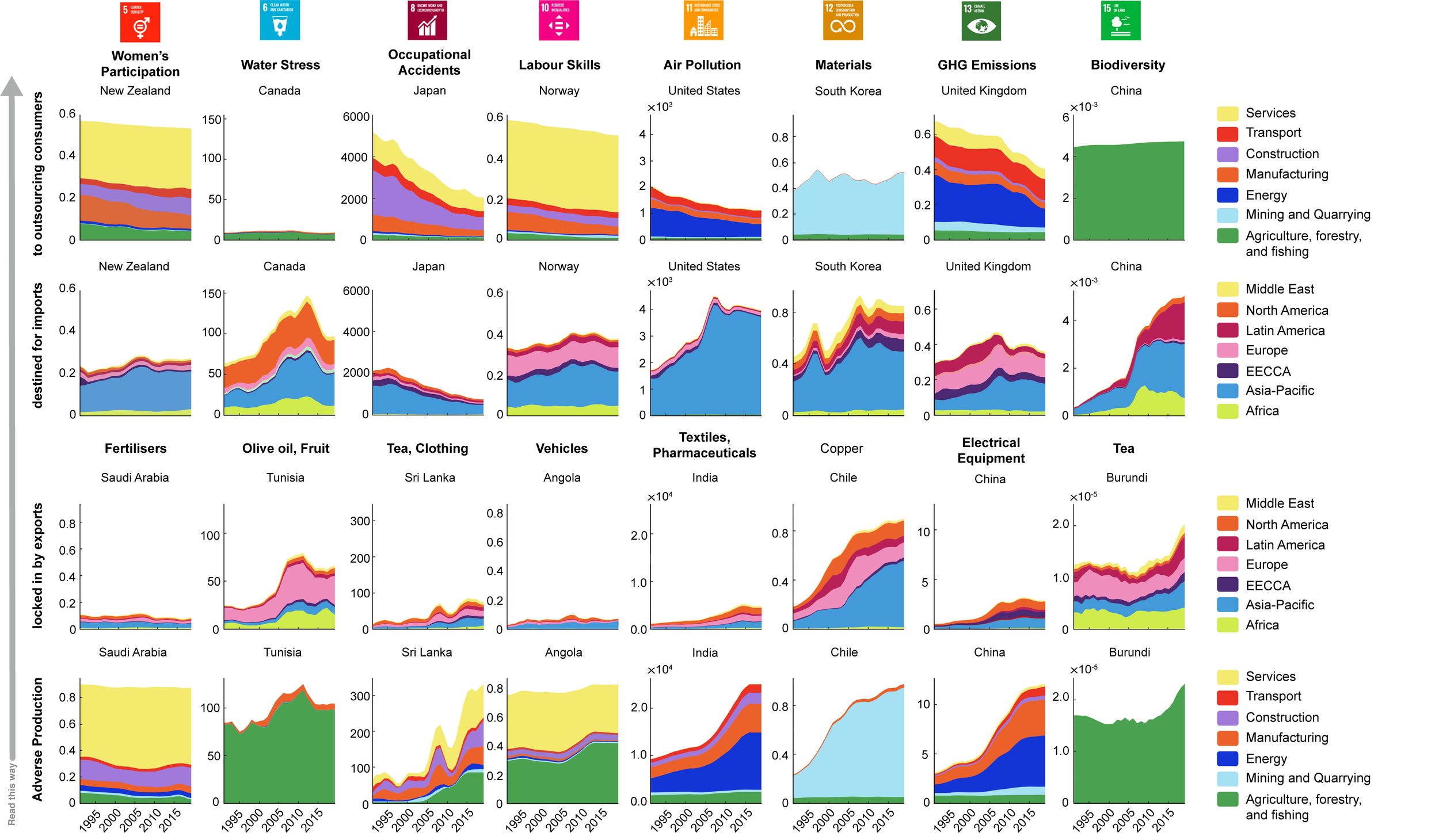The Hidden Costs of Global Trade: Unraveling Supply Chains for a Sustainable Future
Arunima Malik
The University of Sydney, Australia
Winning article: Polarizing and equalizing trends in international trade and Sustainable Development Goals (Nature Sustainability, 2024)
“In today’s interconnected world, where reliance on global supply chains is growing, it is crucial to assess how our actions drive environmental and social consequences in our trading partners.”
Our planet’s health, along with the well-being of its species, hinges on human actions. Human inventions have profoundly shaped the world we live in today. From the printing press and light bulbs to telephones, automobiles, computers, electrical appliances, and airplanes, the list goes on. The Industrial Revolution truly revolutionized the world, as societies transitioned from agrarian economies to industrialized manufacturing hubs, marked by large-scale production of the goods we rely on today. But what is the impact of this large-scale production and growing human demand for goods and services?
As society was further industrialized, humans increasingly relied on the planet's raw materials to fuel their growing consumption. Global supply chains emerged, and the world became inherently interconnected. However, this progress came at a cost to both the environment and society. In today’s globalized world, where we are increasingly dependent on overseas production, it is essential to understand how our actions drive environmental and social consequences in our trading partners. This is the focus of our research: quantifying the environmental and social impacts embodied in international supply chains, with a particular emphasis on analyzing trends over time and progress towards global sustainability frameworks.
Enumerating global trends provides valuable insight into how countries are performing in relation to the United Nations Sustainable Development Goals (SDGs), as well as identifying which nations are driving polarizing effects in their trade partners. Our motivation for researching global supply chains is rooted in a desire to unravel the intricate networks that connect businesses, sectors, nations, and, ultimately, people. These networks not only influence both local and global economies but also play a pivotal role in shaping environmental and social outcomes. By understanding these complex supply chain dynamics, we can inform targeted actions to promote responsible and equitable supply chains in the future. To this end, our work focuses on integrated sustainability analysis of local, national, and global supply chain networks.
Figure 1: Global polarizing and equalizing effects of international trade on SDGs. There are 12 panels, each showing an environmental or social proxy linked to the SDGs. The interpretation of all panels is as follows: polarizing means that international trade improves the SDG performance of selected countries (for example, high-income countries) and deteriorates that of other countries (for example, low-income countries). Equalizing describes a reduction in disparities.
An integrated sustainability analysis recognizes the interconnectedness of the environment, society, and economy. Understanding these interconnections is essential to ensuring that all countries are on track to meet the UN’s 2030 Agenda for sustainable development. Our research focuses on key environmental and social factors, such as greenhouse gas emissions (including nitrogen), biodiversity threats, land use, workplace accidents, and more. These factors are closely linked to the UN SDGs and planetary boundaries. Our quantitative analysis, covering the past three decades, reveals trends that are either polarizing or equalizing over time. Specifically, high-income countries are transferring environmentally and socially harmful production to low-income countries, resulting in a shifting of burdens.
Figure 2: Country-level examples, regional and sectoral composition of outsourcing by SDG proxy. There are eight selected proxies shown in this figure. For each proxy, the interpretation is as follows: the top two rows represent outsourcing regions and sectors, and the bottom two rows represent source regions and sectors for selected SDG proxies.
Our study identifies key contributors to these polarizing trends, which impede progress toward a selection of SDGs: SDG1 (No Poverty), SDG2 (Zero Hunger), SDG5 (Gender Equality), SDG6 (Clean Water and Sanitation), SDG7 (Affordable and Clean Energy), SDG8 (Decent work and economic growth), SDG10 (Reduced inequalities), SDG11 (Sustainable Cities and Communities), SDG12 (Responsible Consumption and Production), SDG13 (Climate Action), SDG14 (Life under water), and SDG15 (Life on Land), many of which directly contribute to keeping ecosystems within Earth’s nine planetary boundaries.
Our assessment demonstrates how global data on economic interactions, integrated with environmental and social indicators in a holistic framework, can provide critical insights into spillover effects and outsourcing. It paves the way for industry-level assessments to understand how corporations in the Global North influence environmental and social outcomes in the Global South, and the ways supply chain operations can be aligned with Agenda 2030 to shift towards environmentally- and socially sustainable practices that reduce environmental harm.
Our research proposes to broaden the SDG indicator framework to measure spillover effects spatially and temporally, and to routinely report on consumption-based metrics. To elaborate:
a) BROADEN the SDG indicator framework to include consumption-based metrics as explicit indicators, such as carbon footprint, land footprint, nitrogen footprint, biodiversity footprint, and others. Currently, the framework includes only one such indicator—material footprint.
b) MEASURE spillover effects spatially and temporally across multiple scales, from local, national to global interactions, to enhance understanding of supply chain linkages. This measurement ought to extend beyond the scope of countries, incorporating industries and businesses to enable a more holistic consideration of the global landscape.
c) REPORT routinely on consumption-based metrics. Spillover data should be systematically incorporated into SDG reporting, including Voluntary National Reviews (VNRs) and global Sustainable Development Reports. By doing so, these reports would offer a more comprehensive assessment of progress toward the SDGs, ensuring that both direct and indirect effects are considered in the evaluation of global sustainability efforts.
Our research has policy implications as routine reporting of environmental, social, and economic impacts of production and consumption could serve to inform effective policies that address negative externalities while rewarding positive trade outcomes, incentivizing desirable behaviors, and penalizing harmful practices within companies. Consumption-based metrics could also serve as valuable insights for global mechanisms such as the Loss and Damage Fund, established under the United Nations Framework Convention on Climate Change (UNFCCC), to provide support to countries affected by climate change. Broadly, our research in supply chain assessments has shown that climate-related disasters have the potential to disrupt global supply chain networks, with vulnerable nations and sectors most affected. Insights on spillover effects can serve to support the Fund’s objectives.
Future research should focus on refining data structures to support the formulation of a robust framework for implementing sustainable practices in global supply chains while addressing their negative social and human rights impacts. Addressing spillovers embodied in international supply chains is one step towards ensuring human well-being and that the planet’s health is preserved for future generations.




